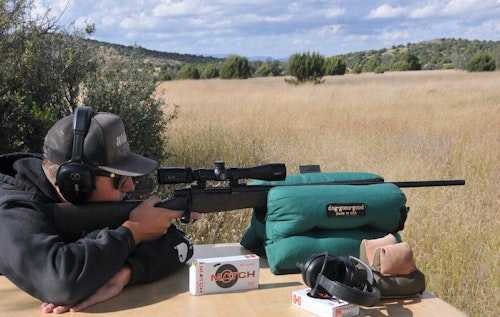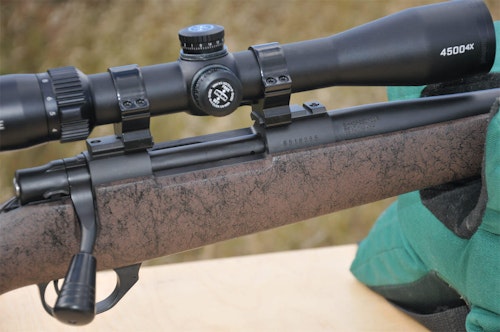Not long after the first 6.5mm Creedmoor rifles came off the assembly line at Ruger sometime around 2008, the sport of precision rifle shooting came along.
Savvy shooters tweaked their 6.5mm handloads with new powders and pushed bullet makers to provide projectiles with better ballistic coefficients and sectional density. This was a game-changer for hunters and long-range shooters.
I bought one of those early Rugers and it remains a handsome big-game offering in a classic walnut stock. It shot extremely well, and it still provides excellent groups and ballistics (depending on the ammunition or handloads used) that were/are equal to the long-popular 6.5 Swedish Mauser cartridge, which, incidentally, was developed for military use. With the then-new rifle, I shot both pronghorns and mule deer in two states with handloads, and still would never think of getting rid of the Ruger rifle.
The popularity of the 6.5 Creedmoor led to other new cartridges, including the dandy 6mm Creedmoor cartridge, a smaller version of the original 6.5mm.
When the 6mm Creedmoor came on the market, it compelled sportsmen, including me, to try it on big game. The long-range precision shooters quickly adopted it, and in some circles, the 6mm is now more popular than the original 6.5mm Creedmoor cartridge. It should be pointed out the 6mm Remington has been on the market since 1963, but the 6mm Creedmoor beats the “ballistic” pants off the classic 6mm Remington and .243 Winchester (marketed in 1955) cartridges.
Practical Cartridge
I sometimes hear from people who are bored with all the talk and attention the 6.5 Creedmoor receives and want to know more about the 6mm version, largely for hunting. This prompted me to call several venders near where I live, and all but one said currently, the 6mm Creedmoor often outsells the 6.5mm Creedmoor, especially prior to hunting season. Another salesman at Sportsman’s Warehouse said 6mm Creedmoor sales have increased in the last two years and his store sells three 6mm rifles for every two of the older 6.5mm rifles. The same is true of the ammunition.
With the rising cost of used firearms, sportsmen who might otherwise go that route are instead looking at new rifles. For the price, a hunter can purchase a rifle that has been built from the bottom up with all the features, accuracy enhancements and top-grade ammunition available today. It’s a matter of finance and practicality. And with the growing popularity of the 6mm, this is a gun you need to stock.
There are hunters who still think the .270 Winchester, or .30-06, are the do-it-all cartridges, and that’s not untrue, but the 6mm Creedmoor is obviously a practical deer cartridge. For many hunters, the new more powerful 6mm cartridge can add interest to hunting, and a new gun is always fun.
My newest rifle is a Howa (Legacy Sports) Model 1500 chambered in 6mm Creedmoor with a Bushnell 4500 4x Elite scope and a 27-inch barrel. Total weight with an aftermarket stock is just under 9 pounds. I’d prefer it weigh a pound or two less, but that would require a custom or semicustom gun, thus driving up the total cost. On my next deer hunt, I plan to use this rifle.
Ammo Options
As noted, there is a new crop of factory ammunition available for the 6mm Creedmoor, and I used several of the recommended options with my Howa. Test loads included Hornady 108-grain ELD Match, Federal Premium Gold Medal Berger 105-grain hybrid open-tip match, and Black Hills Gold 103-grain ELD-X.
Since the gun is new and not fully broken in, it’s expected that some loads will shoot better than other options, although Hornady Match definitely did not like the Howa’s barrel. Upon investigation with a Hawkeye bore scope, it was clear that the bore was slightly rough and needed to be lapped to polish the bore and prevent further fouling. Once this process was completed, the gun shot well and provided groups desirable for hunting — that is, under 2 inches.
Hunters have plenty of excellent ammo options for the 6mm Creedmoor. This includes Hornady Precision Hunter, Barnes VOR-TX Long Range, Sierra Gamechanger, Nosler Ballistic Silvertip, and Berger Match Grade ammunition. As this is written, all are plentiful on the market. Just like factory ammunition, the current market is flush with component 6mm bullets for serious handloaders. This will keep handloading precision shooters and hunters busy shooting into the foreseeable future.
Top Seller
Today, nearly every rifle manufacturer produces a 6mm Creedmoor rifle. These rifles can be found in many price ranges as standard or custom orders.
Some time ago, I had the opportunity to test several rifles in this chambering. There were differences in stocks and some variance in weight but little that would cause a rifle to be discounted. Ruger, Savage Arms, Bergara, Christensen Arms, Gunwerks, Cooper, Nosler, Masterpiece Arms and Seekins all make quality, dependable rifles. And this list continues to grow due to hunter and long-range shooter interest and satisfaction. It is interesting to note how quickly the 6mm Creedmoor has become a top seller, as did its parent 6.5mm upon release. The choice of the 6mm by hunters, shooters and PRS competitors has significantly impacted manufacturing and sales of rifles, scopes, ammunition and handloading components. Current sales appear to show no sign of its popularity waning, which bodes well for market durability and longevity.
The 6mm started as a wildcat, but survived to become a popular mainstream cartridge and rifle combination. It is difficult to imagine what might eventually replace it. Most likely, the 6mm will endure like the faithful .270 Winchester and .30-06.
Undoubtedly, the 6mm Creedmoor will have loyal dedicated users who will never give it up.









